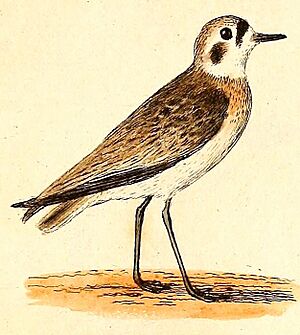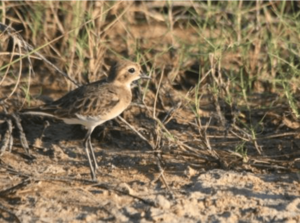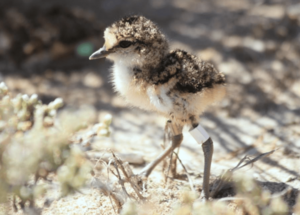Kittlitz's plover facts for kids
Quick facts for kids Kittlitz's plover |
|
|---|---|
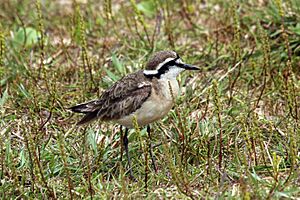 |
|
| At iSimangaliso Wetland Park, KwaZulu Natal, South Africa | |
| Conservation status | |
| Scientific classification |
The Kittlitz's plover (Anarhynchus pecuarius) is a small shorebird. It weighs about 35-40 grams. This bird lives near coastal areas and inland places. You can find it near salt marshes, sandy riverbanks, or grassy areas with short plants. It is found in most of Sub-Saharan Africa, the Nile Delta, and Madagascar. Scientists think it often has more than one mate. Both males and females look very similar.
Contents
About the Kittlitz's Plover
The Kittlitz's plover is a small bird, weighing about 35 to 40 grams. Both male and female birds look alike. They have a black beak, dark brown eyes with black eyelids, and black legs. Sometimes, their legs can look greenish or grey.
During the breeding season, the male bird has special markings. It has a white forehead and a black bar on its head. After that, there is a thin white bar. The rest of its head is brown with sandy-colored feather tips. A black stripe goes from its beak, through its eye, and down its neck. This stripe forms a collar across its upper back.
Its back is dark grey-brown. The other upper parts are sooty brown, with feathers that have sandy-reddish edges. Its face, chin, and upper throat are white. The rest of its belly is yellowish, with a pale lower belly. The central tail feathers are blackish. They get lighter towards the sides of the tail. The outer two pairs of tail feathers are completely white.
Male and female Kittlitz's plovers are about the same size. The female's feathers look very much like the male's. However, her black band across the front of her head is thinner. When they are not breeding, their feathers do not change much. The eye stripe becomes browner, and the front bar is gone. Their underparts also become much paler.
Adult Kittlitz's plovers usually have wings that are 100–110 mm long. Their beak is between 15–23 mm long. Their lower leg (tarsus) is 26–33 mm long. Young Kittlitz's plovers look a lot like adults. But they do not have the black marks on their face. Their upper parts are brown, and the collar on their neck is buff-colored. Their underparts are white.
Where They Live and How They Move
Where They Are Found
Kittlitz's plover lives in most of sub-Saharan Africa. It also lives in Madagascar and the Nile River Delta. A study of their genes showed that birds in Madagascar are a bit different from those on the mainland.
They are common in South Africa. But they are rarer in dry areas of Botswana and Namibia. In Namibia, they mostly live near the coast, in highlands, and in Ovamboland. They are less common in the southern lowveld of South Africa. They are also found in patches in KwaZulu-Natal and the eastern Cape. They usually avoid mountains or thick forests.
The plovers in Madagascar might have come from mainland Africa more recently. Another bird, the Madagascar plover, might have evolved from an older group of Kittlitz's plovers. These two species are clearly different and cannot breed together.
Birds from Madagascar are generally smaller than those from Africa. Kittlitz's plovers in South Africa are heavier and have longer wings than those in Madagascar. Birds from Egypt have longer wings and shorter legs than those in Madagascar. But they are still considered the same species because their feathers look the same.
In Madagascar, Kittlitz's plover lives there all year. Some also move around the island. They have been seen mostly below 950 meters (about 3,100 feet). But they have also been recorded as high as 1,400 meters (about 4,600 feet).
How They Move
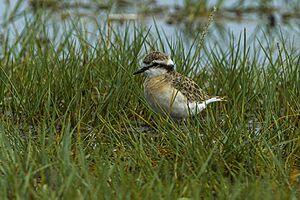
The plovers in Africa sometimes stay in coastal areas. But mostly, they move around or migrate. Their movements change each year depending on how much rain falls. There is not much proof of similar changes in Madagascar. For example, in one area, they are thought to stay put. But at another lake, tagged adults have moved 113 km (about 70 miles) away.
Where They Live
Kittlitz's plover can be found both inland and near the coast. They like open areas that are not too high up. They often prefer dry ground with very short grass, usually close to water. They breed near lakes, grassy areas with salt, lagoons, rivers, tidal mudflats, or inland saltmarshes. They also use man-made water bodies like salt pans. But they usually avoid sandy or rocky beaches.
In the eastern and western Cape, some groups move to estuarine mudflats in winter. This might be because there is less competition from other migrating birds. It also helps them avoid food shortage during harsh inland winters. These birds stay on the ground. They feed, nest, clean their feathers, and rest only on the ground.
Sounds They Make
Kittlitz's Plovers make different calls. These include ‘pipip’, ‘towhit’, ‘tit-peep’, ‘trit-tritritritrit’, ‘perrup’ and ‘kich-kich-kich’. When they are in danger or fly away suddenly, they make alarm calls. These calls include ‘chirrt’, hard ‘trip’, ‘tric’, ‘prrrt’ or sad ‘pip-ip’.
During fights, males make a buzzing call. This happens when they are being aggressive or trying to attract a mate. When a male or female pretends to be hurt, they make a ‘cheep-cheep’ sound. When a parent wants its young to come close, it makes a ‘chip-chip’ sound. The young are warned with a ‘trr-trr’ sound. A young bird's call is a thin ‘peep’.
What They Eat
Kittlitz's plover hunts for food in a special way. It runs, stops suddenly to peck at something, and then runs again. This is called "run-stop-search." Sometimes, a bird stands tall and vibrates one foot on the ground. This is called "foot-trembling." It then lunges forward to catch any prey that comes to the surface. This behavior has not been seen in Madagascar.
They eat day and night. On moonlit nights, they can eat until 11 PM. They often feed in groups of 2-5 birds. Sometimes, they join small flocks with other small waders. When they are looking for food, they can be aggressive. This is especially true towards other plovers or birds that eat similar food. This aggression increases when there are many birds. It is highest in the winter months before breeding.
They mainly eat insects, especially beetles. They also eat insect larvae, spiders, small crustaceans, and molluscs. Most of their food is small. But they have been seen catching a cricket that was about 40 mm long.
Behavior and Life Cycle
When it's not breeding season, these birds are social. They stay in small groups of about 20 birds. But during migration, larger groups of 100-300 birds have been seen.
Reproduction and Territories
Kittlitz's Plover has a flexible breeding system. They do not stay with one mate for as long as some other plover species. They are thought to often have more than one mate. A pair usually forms about 2–4 weeks before they claim their breeding area. They find food within these areas, which can be quite large (3600-4200 square meters). The parents protect their territory very strongly until their chicks hatch. If other birds or animals enter their territory and seem like a threat, the parents chase them. They stop in front of them, stand tall with straight legs, and hold their head up.
Courtship
The first part of their courtship happens in a neutral area. It involves a "scrape-ceremony." One bird puts its chest on the sand and rotates around. It raises its tail and kicks sand backward and forward with its legs.
Usually, the male starts by making several scrapes (small hollows in the ground). Sometimes both parents take turns making them. The female then likely chooses the final nest spot. Both parents pick up small stones or pieces of dead plants to line the nest.
Nesting and Incubation
The Kittlitz's Plover nests on the ground. They breed throughout the whole year. However, the busiest breeding times vary in different places. The simple nest is usually 50–100 meters (about 160-330 feet) away from water. It is on open, dry ground that is not too high up. This makes it easy to spot intruders. The nest is about 10–15 cm (4-6 inches) wide. It is lined with shells, pebbles, animal dung, and plant pieces.
Kittlitz's Plovers usually nest alone or in loose groups. Their nests are often more than 40 meters (about 130 feet) apart. But sometimes they can be as close as 8 meters (about 26 feet). Sometimes, the same pair might reuse an old nest scrape.
Kittlitz's Plovers lay 1-3 eggs, but usually 2. They lay them every 1-2 days. The eggs are oval and dark grey-maroon with black speckles. They look sand-colored or light brown overall.
Incubation starts once all the eggs are laid. Both parents take turns sitting on the eggs. The male usually sits at night, and the female during the day. This lasts for 21–27 days. When a parent leaves the nest during the day, or if a predator comes near, the parent usually covers the eggs. They cover them up to two-thirds or completely with sand. They do this within 3-90 seconds by moving around the nest and kicking their feet. Newly hatched or partly hatched chicks also get covered. Sometimes, the eggs might be left alone for up to 5–7 hours. When the parent returns, it uncovers the nest before continuing to sit on the eggs.
Parental Care
Once the young birds hatch, both parents remove the eggshells from the nest. Newly hatched young are downy (covered in soft fluff). Their upper parts are grey to white. Their back has dark spots and a dark stripe down the middle. Their underparts are white. The chicks leave the nest within a few hours of hatching. Or they might stay on the nest for up to 24 hours.
The chicks are precocial. This means they can feed themselves from 24 hours after hatching. One parent usually leads them to feeding areas up to 1 km (about 0.6 miles) away from the nest. Kittlitz's plovers show uniparental care. This means only one parent (either male or female) stays with the young. This parent keeps them warm often until they can fly. This happens at 26–32 days old.
The parent calls the chicks when it wants them to come close or when there is danger. The parents actively protect their young from other plovers or intruders. They do this by:
- a) Pretending to be hurt to get more attention. They lie flat on the ground, flap their wings as if helpless, fan their tail, or run away from or towards the intruder.
- b) Pretending to sit on a nest that isn't there.
- c) Running with their head held low, tail down, and wings spread.
Chicks and young birds get their adult feathers after one year. Some may start breeding at that age.
Protecting the Kittlitz's Plover
Status and Trends
The IUCN (International Union for Conservation of Nature) lists Kittlitz's plover as a species of Least Concern. This means they are not currently at high risk of extinction. The species is common in Africa and found locally in Madagascar. It lives in a very wide area. We don't know much about how their numbers are changing. It's hard to see how changes to their habitat affect them. But any decreases seem to be small and not threatening.
Kittlitz's Plover is very common in East, South, and Central Africa. There are an estimated 100,000-400,000 birds there. West Africa is thought to have 20,000-50,000 birds. In Madagascar, the population is estimated at 10,000-20,000 birds. This makes the species common in that area.
How Long They Live
Kittlitz's plovers are long-lived birds. They can live for almost 10 years. Some evidence shows that individuals can live much longer than that.
Dangers They Face
Kittlitz's plover is mainly threatened by losing its habitat. This happens when wetlands are damaged. For example, Walvis Bay in Namibia is an important wetland. But it has been damaged by building roads, tourists, and filling in wetlands for new towns and ports. In Ghana, wetlands are threatened by coastal erosion and building projects that drain and fill in wetlands.
The birds that migrate through the east Atlantic could be at risk from avian malaria. They would be in great danger if there was an outbreak of this disease. The same is true for avian botulism, which Kittlitz's plover can get.



